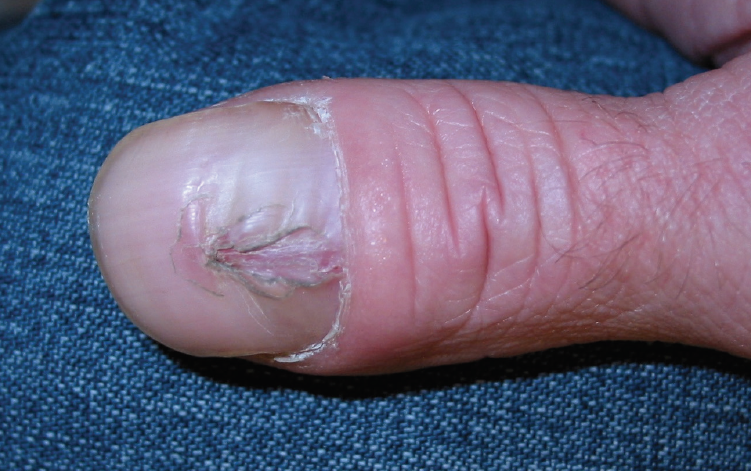Split and Fissured Thumbnails: Benign Condition, or a Sign of Underlying Disease?
A 42-year-old laborer presented with abnormal-looking thumbnails. The lesions had been first noted approximately 4 years ago. There was no history of thumb sucking, thumb biting, or thumb picking. There was no history of contact with irritants.
The man was otherwise healthy and was not on any medications. No other family members had similarly deformed nails. He was worried that the abnormal-looking thumbnails might be a sign of an underlying disease. He was not concerned about the cosmetic appearance, however.
Physical examination revealed paramedian longitudinal splitting in both thumbs with parallel transverse fissures on either side, imparting an inverted fir-tree appearance. There were no nail fold abnormalities or evidence of chronic paronychia or periungual dermatitis. The rest of the physical examination findings were unremarkable.

What’s Your Diagnosis?
- Median nail dystrophy
- Habit tic deformity of the nail
- Onychomycosis
- Nail psoriasis
Answer on next page.

Answer: Median Nail Dystrophy
Median nail dystrophy, also known as dystrophia unguium mediana canaliformis or median canaliform dystrophy of Heller, is characterized by a midline or paramedian canal, split, or ridge in the nail plate of one or more nails, beginning at or distal to the proximal nail fold.1-3 The condition was first described by German physician Julius Heller in 1928 and now bears his name.4
PREVALENCE And ETIOLOGY
The exact incidence is not known. Suffice it to say that median nail dystrophy is an uncommon condition. The sex ratio is approximately equal. The mean age of occurrence is 25.7 years.1
The exact etiology is not known, and the majority of cases of median nail dystrophy are idiopathic.2,3,5 Presumably, the condition may result from a temporary defect in the matrix that interferes with nail formation.6 Median nail dystrophy may result from dyskeratinization, focal infection, or repeated self-inflicted trauma (eg, habitual picking) to the nail or nail bed.1,7,8 The condition may also result from systemic isotretinoin therapy.5,9 Familial occurrences have rarely been reported.3
CLINICAL MANIFESTATIONS
Clinically, median nail dystrophy presents as a midline or paramedian canal, split, or ridge in the nail plate of one or more nails, beginning at or distal to the proximal nail fold.3 Parallel transverse cracks or fissures that extend laterally from the central canal or split toward the nail edge are often observed, giving rise to the appearance of an inverted fir tree or Christmas tree.9,10 The condition is usually symmetric and most often affects the thumbs, although other fingers or toes may be involved.6,10 Thickening of the proximal nail fold, enlargement of the lunula, and redness of the lunula may occur.3,11 The condition is usually asymptomatic.
DIAGNOSIS
The diagnosis is mainly a clinical one, and no laboratory test is necessary for diagnosis. Referral to a dermatologist should be considered if the diagnosis is in doubt.
DIFFERENTIAL DIAGNOSIS
Median nail dystrophy should be differentiated from habit tic deformity of the digit. The latter is characterized by central depression of the nail plate, often accompanied by multiple transverse ridging/depressions, that run from the nail fold to the distal edge of the nail (Photo, below).7,10 These nails lack the characteristic longitudinal splitting seen in median nail dystrophy.10 Habit tic deformity is caused by habitual external trauma to the nail matrix, such as manipulating the proximal nail fold or periungual area.1,7 Longitudinal grooving or splitting of the nail may result from a subungual tumor such as glomus tumor, papilloma, melanoma, or myxoid tumor, mimicking median canal dystrophy.12 Other differential diagnoses include lichen planus, nail psoriasis, onychomycosis, lichen striatus, melanonychia striata, digital mucous cyst, trachyonychia, and nail-patella syndrome.10

PROGNOSIS AND MANAGEMENT
Median nail dystrophy tends to resolve spontaneously over a period of months to years.2,6,8 However, the condition can be recurrent.1,8
Median nail dystrophy is considered a benign condition. As such, no treatment is necessary. The underlying cause, if identified, should be removed if possible. If treatment is desired for cosmesis, one may consider the use of topical calcineurin inhibitors (tacrolimus and pimecrolimus), although publications discussing successful treatment options are greatly lacking.2,6
Alexander K. C. Leung, MD, is a clinical professor of pediatrics at the University of Calgary and a pediatric consultant at the Alberta Children’s Hospital in Calgary, Alberta, Canada.
Benjamin Barankin, MD, is a dermatologist and the medical director and founder of the Toronto Dermatology Centre in Toronto, Ontario, Canada.
REFERENCES:
- Kota R, Pilani A, Nair PA. Median nail dystrophy involving the thumb nail. Indian J Dermatol. 2016;61(1):120.
- Madke B, Gadkari R, Nayak C. Median canaliform dystrophy of Heller. Indian Dermatol Online J. 2012;3(3):224-225.
- Sweeney SA, Cohen PR, Schulze KE, Nelson BR. Familial median canaliform nail dystrophy. Cutis. 2005;75(3):161-165.
- Heller J. Zur Kasuistik seltener Nagelkrankheiten: dystrophia unguium mediana canaliformis. Dermatol Z. 1928;51(6):416-419.
- Dharmagunawardena B, Charies-Holmes R. Median canaliform dystrophy following isotretinoin therapy. Br J Dermatol. 1997;137(4):658-659.
- Hoy NY, Leung AKC, Metelitsa AI, Adams S. New concepts in median nail dystrophy, onychomycosis, and hand, foot, and mouth disease nail pathology. ISRN Dermatol. 2012;2012:680163. doi:10.5402/2012/680163
- Perrin AJ, Lam JM. Habit-tic deformity. CMAJ. 2014;186(5):371.
- Winther AH, Bygum A. Can median nail dystrophy be an adverse effect of alitretinoin treatment? Acta Derm Venereol. 2014;94(6):719-720.
- Alli N, Dogan S. Short-term isotretinoin-induced elkonyxis and median nail dystrophy. Cutan Ocul Toxicol. 2016;35(1):85-86.
- Latham L, Langley R. Can you identify this condition. Median canaliform nail dystrophy. Can Fam Physician. 2013;59(5):511, 513.
- Wu C-Y, Chen G-S, Lin H-L. Median canaliform dystrophy of Heller with associated swan neck deformity. J Eur Acad Dermatol Venereol. 2009;23(9):1102-1103.
- Verma SB. Glomus tumor-induced longitudinal splitting of nail mimicking median canaliform dystrophy. Indian J Dermatol Venereol Leprol. 2008;74(3):257-259.


